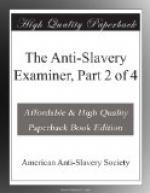This profound legal opinion asserts, 1st, that Congressional legislation over the District, is “the legislation of the states and the people.” (not of two states, and a mere fraction of the people;) 2d. “Over a District placed under their control,” i.e. under the control of all the States, not of two twenty-sixths of them. 3d. That it was thus put under their control “for THEIR OWN benefit.” 4th. It asserts that the design of this exclusive control of Congress over the District was “not for the benefit of the District,” except as that is connected with, and a means of promoting the general advantage. If this is the case with the District, which is directly concerned, it is pre-eminently so with Maryland and Virginia, which are but indirectly interested. The argument of Mr. Madison in the Congress of ’89, an extract from which has been given on a preceding page, lays down the same principle; that though any matter “may be a local affair, yet if it involves national EXPENSE or SAFETY, it becomes of concern to every part of the union, and is a proper subject for the consideration of those charged with the general administration of the government.”—Cong. Reg. vol. 1. p. 310.
But these are only the initiatory absurdities of this “good faith implied.” Mr. Clay’s resolution aptly illustrates the principle, that error not only conflicts with truth, but is generally at issue with itself: For if it would be a violation of “good faith” to Maryland and Virginia, for Congress to abolish slavery in the District, it would be equally a violation for Congress to do it with the consent, or even at the unanimous petition of the people of the District: yet for years it has been the southern doctrine, that if the people of the District demand of Congress relief in this respect, it has power, as their local legislature, to grant it, and by abolishing slavery there, carry out the will of the citizens. But now new light has broken in! The optics of Mr. Clay have pierced the millstone with a deeper insight, and discoveries thicken faster than they can be telegraphed! Congress has no power, O no, not a modicum! to help the slaveholders of the District, however loudly they may clamor for it. The southern doctrine, that Congress is to the District a mere local Legislature to do its pleasure, is tumbled from the genitive into the vocative! Hard fate—and that too at the hands of those who begat it! The reasonings of Messrs. Pinckney and Wise, are now found to be wholly at fault, and the chanticleer rhetoric of Messrs. Glascock and Garland stalks featherless and crest-fallen. For the resolution sweeps by the board all those stereotyped common-places, such as “Congress a local Legislature,” “consent of the District,” “bound to consult the wishes of the District,” with other catch phrases, which for the last two sessions of Congress have served to eke out scanty supplies. It declares, that as slavery existed in Maryland and Virginia at the time of the cession, and as it still continues in both those states, it could not be abolished in the District without a violation of “that good faith,” &c.




